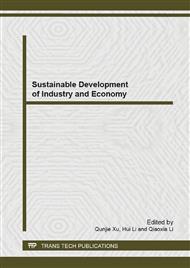p.541
p.545
p.549
p.554
p.559
p.564
p.569
p.573
p.581
The Feasibility Analysis and Pathways Study of China’s 2020 Non-Fossil Energy Target
Abstract:
In 2009, Chinese government proposed the 15% target of non-fossil energy share at 2020, and obtained the general concern of the international community. The paper considers the constraints of economic growth, decrease rate of GDP CO2 intensity and primary energy structure to discuss China’s CO2 emissions and primary energy demand in sub-scenarios. Then through the analysis of consistency with the overall economic growth and energy planning and the international society’s expectation on China’s GHG abatement duty to demonstrate the feasibility of the non-fossil energy target. The results show that the 17% of non-fossil energy can meet the various constraints. Finally pathways to realize clean energy development into 2020 are outlined.
Info:
Periodical:
Pages:
559-563
Citation:
Online since:
December 2013
Authors:
Keywords:
Price:
Сopyright:
© 2014 Trans Tech Publications Ltd. All Rights Reserved
Share:
Citation:


